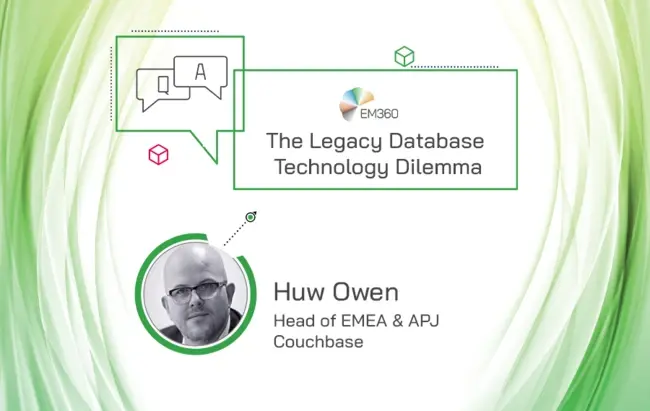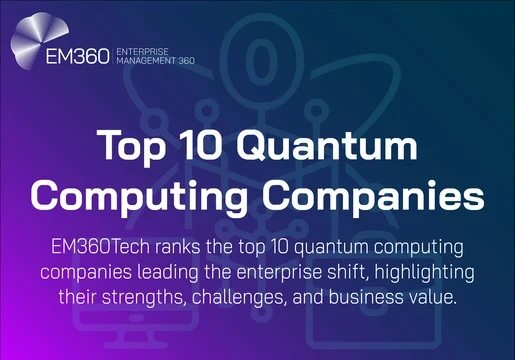The argument that legacy systems are holding the enterprise back is not new. Over the last five years, technology analysts have spoken about the negative impact of outdated technology on digital transformation in the finance sector. Concerns have since grown as with the COVID-19 pandemic accelerating digital transformation, the digital-driven future is now. Businesses need to adapt to new technologies and venture into new digital services if they wish to thrive and remain competitive. Utilising and relying upon legacy technology only prohibits this.
Huw Owen, Head of EMEA and APJ at Couchbase, knows all too well about the legacy technology dilemma. A tech industry veteran who has been helping some of the world’s biggest organisations to digitally transform, Huw has been campaigning for companies across all sectors to move away from using old computer software, hardware, and databases.
In this Q&A, we discuss the challenges that businesses continue to face with legacy technology, using the database industry as a case in point to show how businesses' legacy arrangements are hindering their chances of being competitive in the post-COVID, digital-first world.

What is the crux of the legacy technology dilemma and why do you think that the database industry is most at risk in the post-COVID, digital-first world?
Many organisations are still relying on legacy technology, which was built for a different world to now. Previously it was the final purchase that mattered, not the steps the customer took to get there. Now it’s the opposite, with the interactions and the whole customer journey taking centre stage. Take legacy relational databases for instance, which were engineered to focus specifically on carrying out the final transaction. These databases are now becoming largely irrelevant for modern enterprise applications as today sees hundreds of different interactions happening all at once. With efforts now concentrated on delivering unforgettable customer experiences, we need technology that supports the entire journey and not just the final transaction.
Like a pair of old, fraying jeans, many businesses are still using legacy technology despite knowing it will become outdated. It's important businesses cast away their legacy beginnings and adopt modern innovations if they wish to meet customer expectations.
Hotel chain Marriott is one such company that has realised this need. To maintain its competitive edge, Marriott adopted a move to the cloud to replace its legacy infrastructure. This has facilitated personalised customer experiences, improved online reliability and quicker delivery of new apps.
Marriott recognised that while legacy technology has its place, it’s often incompatible with newer demands, and can hold back the rate of digital transformation. This makes organisations far less efficient and attractive towards consumers. It also results in competitors gaining a real advantage as they storm ahead with innovation and high customer satisfaction.
Couchbase carried out a survey in the last year about the digital transformation demand and its associated challenges, in which an astounding 90% of enterprises said they rely on legacy database technology despite it disrupting business agility. Has this figure lowered since then and can you tell us about some of the other constraints presented by legacy systems and infrastructures?
The number of businesses utilising legacy databases has actually increased, with 100% of respondents saying they still rely on traditional databases. This is due to disruption from covid-19 causing them to put their modernisation plans on hold, as they sought to overcome the uncertainty.
This presents many difficulties, namely the challenge of switching away from tried and tested technology that’s been in place for years. Those that fail to make the switch, could see competitors leap ahead. Eventually, the needs of the business and capabilities of modern technology will stretch beyond what legacy technology can offer. There will also come a time when the cost of legacy systems, from management to missed opportunities, will outweigh the cost of upgrading to newer technology.
If legacy technology is such an issue, why do so many still use and rely on it?
Again, like that old pair of jeans you’ve had for years, companies find it convenient to keep using these systems. These technologies often get baked into a company’s infrastructure because of the sheer volume of data, time and money invested into them. Organisations simply find it too hard to make the shift. As a result, they haven’t made it a priority to transform their infrastructure.
Often businesses still find these technologies valuable because a lot of critical processes and applications still rely on them. As such, it discourages organisations from swapping out these old technologies. They simply don’t see the point of switching if the system isn’t broken. It’s viewed as more efficient to stick with the familiarity, than having to invest in something new that will require business-wide reskilling.
In the end, though, organisations will be forced to move to newer technology. The cost of maintaining and managing legacy systems will become too much, alongside the daily business pressures to do more with technology. It’ll become vital for companies to shift away from their legacy beginnings.
NoSQL has been hailed as the key to supporting next-generation applications by leading tech experts since 2016. What are the benefits of transitioning from legacy technology to NoSQL databases?
Whilst many organisations still rely on databases that focus on the final transaction, it’s important to have a database that can handle transactional data and support modern applications. With a NoSQL database, businesses have a greater level of agility; they’re able to support the entire customer journey with easier, quicker deployments of new applications and in-built scalability and adaptability so all business needs can be met. Not only that, but newer databases offer an easy upgrade away from legacy architecture to make digital transformation as effortless as possible.
With increased speed and flexibility, NoSQL databases enable enterprises to craft more interactive, enriching experiences for consumers while keeping costs to a minimum. Edge computing is one area where NoSQL comes into its own, enabling end-users to have a great experience regardless of connectivity and syncing changes once it encounters a signal again. This is what happens when an individual pays for the London Underground via Google or Apple Pay and the payment is still successful despite having no internet connection. This is thanks to the mobile database storing relevant information on the device. Retailers can also use these databases to create a 360-degree view of the customer, enabling more immersive omnichannel experiences.
Amadeus is a great example of a company that’s using a NoSQL database to accelerate business growth. As a global travel provider, Amadeus uses its database to process a high workload of travel bookings, knowing its scalability will mean the platform grows at the same rate as the enterprise. At the same time, Amadeus has transformed the customer experience with higher availability and no outages.
In the case of replacing existing legacy technology, how should organisations go about transforming their digital capabilities?
When looking to replace legacy technology, organisations should take a goal-orientated approach. The end goal should be kept in mind – whether that be improving the customer experience or keeping the lights on for day-to-day maintenance – to ensure any new innovations they adopt will truly make a difference. There’s nothing worse than a business deploying a new system to find it doesn’t offer them the scalability or agility they need to operate successfully.
Organisations must also make sure they’re not just swapping one set of problems for another. For instance, if they wish to move to the cloud there’s a whole set of issues such as vendor lock-in and price inflexibilities that must be considered. To avoid this, enterprises need to ensure they’re using innovations that are designed for the cloud, with the flexibility and scalability required.
To wrap up, are there any useful case study examples you can share about how Couchbase, as an award-winning NoSQL cloud database, is helping the enterprise to successfully digitally transform?
One example is when high-profile fashion company, Tommy Hilfiger, used Couchbase to create global Digital Showrooms. This allowed buyers to browse collections, view pieces and see what different outfits would look like virtually via touch screen workstations and high-resolution 4K screens. The database allowed for information to be viewed quickly and in real-time, negating the need to create and send samples to locations all over the world. The database platform supported a one-click ordering system allowing for a faster sales cycle and the ability to easily add new product lines and functionalities. The retailer also had access to in-depth analysis of customer orders allowing for a more personalised approach for future orders. All in all, it delivered a faster time to market with the trip direction reduced by 66% and sample production cut by 80%, enabling the brand to set up more than 25 Digital Showrooms for anywhere, anytime engagement.
Global retailer Tesco also turned to Couchbase to power its catalogue and inventory management, which supports millions of products in-store and online for millions of customers. The company faced the issue of having data stored in multiple legacy databases and were struggling to access this quickly for providing instant updates to customers. Additionally, they were struggling to support changing levels of data and data structures and needed an alternative that would allow them to become far more agile. The NoSQL database provided by Couchbase meant 10 million products and 35,000 requests could be supported per second with low-latency access to thousands and thousands of documents for an improved customer experience. With a more flexible and modern system, Tesco was able to deliver a superior, seamless customer journey with running price and promotion, stocking, shopping cart, supply chain and new product applications that ensure high performance and availability.







Comments ( 0 )